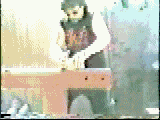
|
Breaking Any
discussion of breaking must address the fundamental
questions. Why do it? Where does it fit in to what I'm
practicing? How does it advance my study of the martial
arts? Didn't Bruce Lee say, "Boards don't strike back." I don't think Lee was speaking against breaking per se, as much as he was about overly focusing on a single skill to the detriment of others. Regardless of your feelings, the time will inevitably come when you have to confront the issue of breaking, and decide for yourself whether to completely ignore it, dabble in it, become proficient at it, or to master it. I believe I was a "dabbler" when I first met up with Master Isidro Archibeque. I was able to hit and kick hard, and in a pinch, could break pine boards, but it wasn't anything I actively practiced. Archie (Master Archibeque prefers to be called "Archie") was of a much more dedicated persuasion. He had spent a lifetime mastering breaking, and by the time I hooked up with him, elevated it to high art. I remember sharing a demonstration with him, then commenting afterward about how I had decided against breaking as a personal path. He looked at me and shook his head, noting I had so much talent, but would forever be lacking the fundamental tool. I questioned his meaning, "What tool are you talking about?" He answered, "Sure, you can punch, kick and block, and you have speed and movement, but you don't have the A-bomb?" Puzzled, I asked what he was referring to. "You need to know that, when necessary, you can strike and destroy. If anybody moves on me, after the first hit, they know they're in trouble. You're stuck in that tournament mind set, where you're sparring with the aggressor. Don't you get it. That's not real! Do you think for a second what you see on the screen is what happens in a real fight. Somebody attacks me, I block, evade, parry, whatever! Then I counter. When I counter, I expect the fight to end. If the opponent is still standing, he or she will be standing with a broken sternum, or fractured limb. No matter, because I'll hit them again. Then it will end!"
I told him I could hit him with any number of techniques, and that my "bomb" could be a reverse punch, a well placed front kick, a spinning side kick, all which I could execute at high level. Delighted at my response, Archie commanded, "Show me" then dropped into a fighting stance. He remained still as stone, then commanded "Show me your A-bomb!" Before he finished the sentence, I was airborne, launching a spinning side kick. He gracefully stepped outside the power, them dropped me with a hand strike that couldn't have covered more than 5" of space. I looked at him from the ground, the fight knocked out of me, and struggled to regain my breath, ... and dignity. "That's my A-bomb," he said, staring down, "Actually, that was more like my C-bomb, since I held back to avoid hurting you." I got the point. Developing impact power through breaking is an important skill, and should have a place in every artist's growth curve. Breaking develops confidence. It's either yes, or no. You can do it or you can't, and when you can do it, it will be there for you when you need it. Breaking also develops focus, more so at the advanced levels, where breaking stacks of objects, or rocks, or doing speed breaks of unsupported targets requires a level of focus bordering on transcendental. Then there's what I call the "George Foreman" factor. Power doesn't diminish significantly with age. As you age, you'll notice you lose a bit of speed, and also some of your flexibility. But you'll find striking power remains, and in some cases even increases, just like the loyalty of a good friend. Master Archibeque was still improving his power strikes as he approached 60 years old, and continues to develop them even today, two decades later. Perhaps that is why he steadfastly maintains, "Everybody needs the Bomb!" How Far Should You Take It? Breaking
can be a jealous mistress, and like many aspects of the
martial arts, can become all consuming. Do you work the
hands, or the feet, or both? What about the elbows and
the knees? What about different striking surfaces, the
palms, the fingertips, side of hand, forearm, wrist,
heel, forehead, etc.? Archie, who is affectionately known as "Iron Hand Archie", has worked all of the striking surfaces. I have experienced his power, and in many respects, it is a supra natural experience. I questioned once that he seldom used kicks in responding to incoming attacks. He ordered me to attack. As I came forward, a half front kick nearly collapsed my pubic arch. "My legs are too powerful, I don't want to hurt my students, or my friends." I have seen him do every Iron Hand technique you've ever heard about. His greatest exploits were in the 1970's when he was demonstrating regularly, but unfortunately before the advent of truly portable video equipment. Some of his breaks are featured here, but many of his greatest efforts are imprinted in my memories, and no where else. I've seen him drive nails into boards, break stacks of bricks, tiles, boards, studs, etc. He once drank a soda, put the cap on the plastic bottle, then took it out to the demonstration where he did a finger strike, penetrating the bottle. Typically, he would practice by breaking stacks of rocks, using whatever strike motivated him at the moment. Over the years, all of the impact surfaces hardened on his body, but particularly his right arm and hand. The hand is nearly 50% larger on the right side, and has a noticably unnatural feel to it, as though it were made of stone, with a covering of leather. Once on a visit to his physician, Archie was asked to give his arm for a blood test. Knowing what would happen, he held up his right arm. Of course, the medical technician couldn't get the needle to penetrate his hide. After a few minutes, he jokingly said, "You should ask me for my left arm." The technician did, and the problem was solved, but not before everybody in the office was called to witness the phenomena. Archie basked in the attention. How far should you take it? Archie would not encourage that you take it to his level. He would prefer you spent the time developing diverse skills, but always being mindful that the core of your skill packet should be a place of hidden but certain power. Specifically, you should be able to break a 1" pine board with any strike, and with any impact block. At Black Belt level, you should be able to split rocks with hand strikes, boards with kicks, and on occasion, bricks, and/or stacks of bricks. Phases of Training Training starts with progressive exposure to impact striking. Concurrently, the student is taught proper hand positioning, and proper alignment of the skeletal structure, set upon a solid stance. The student then learns to fully utilize hip rotation to augment the power curve of all kicks and strikes. This brings to mind a demonstration where I was using a 28" rattan stick to show its striking characteristics. Afterwards, a member of the audience commented how the tremendous acceleration of my hands was as important a factor as the stick. To his disbelief, I explained that my arm had not in fact moved with the strike. Rather, it was locked to my body, and it was the combination of foot position, combined with hip rotation that produced the underlying power for the break. The hand and arm were the delivery vehicles, and were important not for producing the power, but for delivering the power on target. If you closely observe video of the great breakers, you will inevitably see their power comes from efficient coordination of many variables. Since the hand is what you see, it's what you focus on, but it can be misleading. Step back and look at the big picture, what are their legs doing, how are they postured, see how the entire spinal column is acting like a steel spring, note how the force vectors are amplified by the well timed turn of the hips. Don't forget the secret of Miyagi Karate (Karate Kid #1).
Proper hand positioning is a course in its own right. Ever notice how your wrist will sometimes give or collapse on impact (We address that elsewhere in the Iron Crane Dojo. Click here to see the lesson ). Students of Isshinryu learn the vertical fist as their fundamental hand weapon. The vertical fist, with thumb locked above the forefinger notch, anatomically stiffens the wrist and forces proper alignment of the knuckles, to wrist, to elbow, and with some practice, to shoulder. That adjustment alone will significantly increase your forward impact power. If you use the same position for a hammer fist, or backfist strike, you should sense the power increment immediately. Did you know this fist position was originally guarded as a secret technique on the island of Okinawa? There are many positional techniques that can be found through study, research and experimentation. For example, the Hap Ki Do "Ki" hand used with elbow strikes, not only increases their impact power, but enhances your ability to resist wrist locks, if grabbed. Once you've found the hand positions you prefer, start attempting to break 1" pine boards. Remember, the operative word here is pine. Pine breaks clean, and is generally consistent in quality. Other varieties of wood may be significantly more costly, and have different, undesirable breaking characteristics. You can buy them at any hardware store. Get the 12" wide stock, and pay them to cut it into 8-10" lengths while you wait (for demonstrations, it looks better to use a 12x12x1" board, but for practice, you save money by using the shorter boards, and the break is essentially the same). Start with a single board, with a partner holding it for you. Use a reverse punch, so you can get full benefit of the hip rotation. At first, there's a pain threshold to reckon with. You don't have to do the break first time, or even first day. Work up to it. But don't give up! One thing you'll need to be sensitive to is whether your partner is holding the board properly. There should be no backward lean when the strike occurs. The holder's arms should be locked straight, and the legs planted in a stance. Breaking should be considered to be a partnership undertaking. The holder's job is to assist the break wherever possible. My recommendation is the holder grip the board 1/3 down, and not at center. Your strike should be between the holder's hands. The holder should put tension on the board (bending it toward himself) just before the strike, and as you start your strike, the holder should lean slightly forward and into it. A solid hit will shatter the board. If done properly you should have minimal if any residual discomfort.
Once you can confidently break 1" boards, you are ready for Phase II of training. For that we utilize synthetic breaking boards. These are available through advertisements in the martial arts publications. Generally, they are two halves of synthetic which snap or lock together in the center. They are made to "give", or to split, when subjected to a predetermined force. I own four boards for practice, and each has had thousands of breaks, and still performs "like new." Recognizing that wood boards average 75 cents a break, you can quickly see the advantage. The boards I use are each equivalent to two pine boards, so it's a harder hit. The surface of the synthetic boards is like concrete, so multiple strikes without some protection is asking for a collection of bone chips. I will typically wear a pair of bag gloves, and execute 25-50 hits with each hand, per session. With kicks, I usually wear dojo shoes. Because these are not true boards, the holder must adjust to holding the board midway. Everything else is the same. After a month of working the synthetic boards you'll feel much more confident with regular boards, and should be able to break one or two, hand held, with confidence. You're ready for the next phase. Phase III is multiple layers of material. Once you've solved the single board break, increase it to two. It is possible to do a three board break, with someone holding, but it's a much more difficult break than you can imagine, and requires great skill on the part of the holder. I should also caution that when breaking multiple boards, always ensure the grain of all boards is running the same direction, and that the direction of the grain is consistent with the intended impact. Setting targets at cross grain will give you a quick lesson in humility. The same applies with synthetic boards. They are not well suited for stacking in multiple breaks, and cumulatively, become much harder to break when stacked one against the other. Most serious students will only do multiple layers using vertical supports. Some use cinder blocks, some prefer blocks of wood, Archibeque likes heavy duty car jacks. I have used twin 3' railroad ties, which can still be found in the marketplace. When stacking layers of wood, you'll have to make some choices. If you stack one on top of the other, the density of the target will be quite high, and the impact into the target will have to be significant. Remember, the 1" board purchased at the store is really .75" (that's how they're sold. If you demonstrate using them, they are still referred to as 1" boards. Genuine 1" boards simply don't exist in the marketplace). If you stack two, you're penetrating 1.5", if you stack four, you're penetrating 3", and so forth. It is not uncommon for martial artists to shatter knuckles or break wrists in attempting breaks of 3-4 boards stacked one on top of the other. Basically, as the layers of wood become thicker, they begin to support each other, and before you know it, it's like hitting a 4"x4" log. That's the reason you see many demonstrations of breaking with separators between the layers of wood. That's not to say it's impossible to break a 4x4. Master Archibeque has done it, just like he's broken a 1" plywood laminate board. Those breaks are not intended for mere mortals. They involve considerable risk of serious injury. The separators spread the layers of wood apart, resulting in two important consequences which assist the breaker: 1. There is a phenomena where, if separated, the first board will drop down with impact into the second board, actually dispersing residual unutilized force from the first board downward for use against the next board. And so forth...; 2. The use of spacers lessens the density of the combined wood targets, lowering the amount of impact force required per cubic inch of volume, to effect the break. Now I don't want to digress into equations and mathematics here. Think of it like riding your bicycle up a hill. You drop to a lower gear, and you can do it. It still takes the same energy expenditure (actually, it takes a bit more, but I don't have time to go there) to get to the top of the hill, but utilizing the energy more efficiently makes the hill climb possible. The same applies to the stacking of boards. A person who consistently breaks two boards held by a partner, should be able to break 5 boards stacked, separated by 3/8 to 1/2" spacers. Now, even if you stop your training at this stage, you've surpassed 90% of the martial artists, and should be proud of your accomplishment. You have probably gained the benefits of focus, and confidence, and even Master Archibeque would consider that you had a "grenade," if not an A-bomb. Frankly, that's enough for self defense purposes. Your striking surfaces are hardened, but not deformed, and besides, you've got other things to master. But, if you must hear more, here goes.
Along with the speed break is breaking multiple targets at multiple levels (usually four boards along four points of a circle). This develops additional speed, and focus, and requires that you adjust for power on the fly, which is a very important skill in actual self defense situations. For sure, use the break a boards for this, or you'll end up breaking your wallet along with the pine boards. There's not much to say here, except apply the same technique and focus that you use for a single board, to each board. Your ultimate objective is to break 100% of the boards 100% of the time. You should also time yourself as you do this, so you can become more efficient with practice. Eliminate unnecessary movement, purge those extra steps. Finish one target, and close quickly to the next target with one step, never more than two. Doing the same sequence in half the time will advance your art and your self defense immeasurably. Rocks and Bricks
Rock breaking requires a very solid and reliable base. I use a 125 lb anvil, Archie uses a section of railroad track mounted on a wood stump, or in the alternative, a custom welded car stand. Chinese Masters sometimes use the head of a sledge hammer. Generally, because of their molecular structure, and complex irregular shapes, rocks are unpredictable. Their integrity also varies considerably from one source location to the next. What I'm saying is that all rocks are difficult to break. However you might find a lucky spot where the specimens are difficult but "do-able". The next time you might pick a different location, and find the rocks have the consistency of titanium. The important thing to remember in striking a rock is you don't simply lay it down on the target platform and start hitting it (Archibeque can do this, very few others can). If you try that approach, you'll find your power travels through the rock and is dissipated without effect into the supporting base. Also, your hand will experience true pain, or worse. The rock must be lifted slightly from the base, so there are two impacts, one from above, and the second from below. The lift is very subtle, never less than 1/4" or more than ½". It took me several weeks to break my first rock, and several hundred hits. When you work with rocks, you can't hold back. As you progress, your strikes will shorten, and you will start compressing your power over the shortest distance. Like all breaks, you can use any of several striking surfaces, I prefer to use the side of my hand, and to avoid punching, but that's personal preference only. The best lesson on rock breaking is to look at the accompanying video clips, where Master Archibeque performs a practice routine with typical panache. The only other comment about rocks, is that each presents its own challenge. You'll find you start reading rocks as soon as you pick them up. There might be something about the shape or a line on the surface, which clues you on how best to strike it. Follow your instincts, and learn to trust them. That's part of the lesson. However, when you start talking to rocks, it's time to work on something else.
I'm including a video clip of Archie breaking a 1" plywood laminate panel. That's pretty much the ultimate break. If you don't believe me, go buy a panel, mount it, and start hitting it with a sledge hammer. After 10-15 swings you'll know what I'm talking about. Sifu Archibeque did this on the occasion of my promotion to 5th degree Black Belt (10/28/89). He wanted to do something special to commemorate the occasion. The performance is breath taking. I've seen him do it elsewhere, but this is the only time someone had a camera up close. He is in his mid 50's as he does this. Loose Ends In closing, I'd like to address some loose ends. Do I use lotions or ointments? Yes, but rarely. They are not a regular part of my training regimen. Some of the lotions and formulas on the market are quite remarkable, but their effects are generally not long lasting, the ultimate benefit coming directly from the training itself. As a general rule, if you don't know exactly what benefit you get from the lotion or ointment, you should avoid the path, and vice versa. The Gun Fu style is based on "mind over matter" and places great emphasis on what you can cause to happen within yourself. Just about everything else is considered superfluous. There is at least one caution you should take. Some of the Di Dat Jaw formulas contain very potent and toxic ingredients, and if used improperly, or ingested, can result in serious injury or illness. Again, take care! When I train for a major break, how do I prepare myself? As a general rule, whenever you plan to undertake an extraordinary physical undertaking, you should elevate your "average" or "ordinary" performance plateau to at least 50% of the planned performance level. So for example, if you intend to run a marathon, you should practice until you can comfortably run 10-12 miles at a time. If you intend to break seven patio blocks, you should be able to break 4 blocks 100% of the time. In the month preceding the planned break, you should do at least four 4 block breaks (yes, it does get expensive, but that's a different issue). The reason you take this approach is because practicing by running daily marathons is deleterious to the system, just like practicing with 7 block breaks will eventually overload your anatomy. Take it to where you're not damaging the equipment (your body), make that your average, raise the average whenever you can, and understand that on special occasions, you can double that level of performance and succeed. How do I maintain the skill? To some degree, learning breaking is like learning to ride a bicycle. The basic skill remains, and the benefit continues. However, extreme breaking must be continually practiced and refined, or it will deteriorate. I don't continuously work on extreme breaking, since I consider myself something of a guitarist, and am protective of the sensitivity in my hands. I make it a point to spend several months each year advancing my striking techniques, then for the balance of the year, maintaining them with regular work on the Makiwara pads. My final comment is that after undertaking the study of breaking, and hearing what Master Archibeque had to say regarding its importance within the context of complete training, I came to my own subjective insights I'd like to share in closing. Breaking, for me, is a metaphor for life's problems, and challenges. The rock stares back at you , never mocking, but never leaving. Archie stipulates that once you challenge a rock, you must respect it. That means you are not done with the rock until you break it. Don't put it down, and look for an easier one, and don't give up on it. When I struggled with my first rock, I put it in my pocket, and walked around with it until the day came when I could break it. That skill has come to my aid many times subsequent when the rock came disguised as a business or life challenge, and I had to measure it out, and strive for the seemingly impossible solution, until the crisis dissolved before my eyes. A nice feeling indeed! |
[Home] [About Us
] [Archie] [Concepts] [Contact Us]
[Gun
Fu Manual] [Kata]
[Philosophy] [Sticks] [Stories] [Web
Store] [Terms of Use]
[Video]
Copyright 2000-2025, Mc Cabe and Associates, Tacoma, WA. All rights reserved. No part of this site can be used, published, copied or sold for any purpose, except as per Terms of Use .
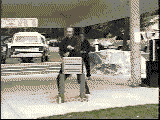
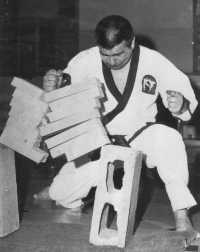 He asked me, "Where's your "bomb"? What can
you hit me with that will stop me dead in my tracks?
Forget about the front kicks and sidekicks. They're
fine. Just tell me where your "bomb" is!"
He asked me, "Where's your "bomb"? What can
you hit me with that will stop me dead in my tracks?
Forget about the front kicks and sidekicks. They're
fine. Just tell me where your "bomb" is!"
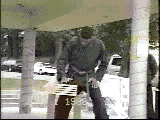
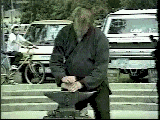 As you're working on the challenge of
single boards, you'll want to institute a regular
regimen of Makiwara (impact board) training. The
Makiwara comes in many varieties and shapes. It can be
as simple as nailing a piece of ensolite (they're
available as knee cushions in just about every garden
store or nursery) pad to a tree, or as complicated as a
Wing Chun dummy with padded hitting surfaces (Recall
Jackie Chan's exhibition in Rumble In the Bronx
). I use a hand made pouch, filled with aquarium gravel
(the heavier duty 1/4" pebble size). There are loops and
eyelits placed strategically on the pouch, so I can hang
it where I choose, or even suspend it. Typically, I'll
mount it on a 4x4 structural support post (nice and
solid). I might do some stretching, and between
stretches, execute 50 punches into the target, gradually
hitting harder, and focusing on penetration. I used to
fill the bag with rice, but rice would turn to powder
after a month, and require replacement, something I'm
pretty much able to avoid with the gravel. My punches
are sometimes from a horse stance, sometimes reverse
punches, sometimes lunge punches, and sometimes
variations of the above, usually over compressed
distances (1", 5", etc.). I personally enjoy executing
multiple back fists into the target (as in 20 sets 3 at
a time). I find that works wonders for the power in my
backfist strike. I have a second Makiwara which is a
commercial product. It's made in China and is a board
with 3 our 4 splits in it, and a spring on the inside.
There is a cover pad and the Chinese characters for
empty hand on the surface. Basically, when you hit the
device, it collapses into itself against the tension of
the spring, and gives a very nice resonant feedback to
the technique. I don't use this for heavy duty impacts.
Rather I will position in front of the target, stick my
fingers out so they just touch the surface, then try to
explode into the target, closing my opened hand into a
fist, and driving it forward. That's really the secret
to developing 1" striking power. And it's great fun to
boot!
As you're working on the challenge of
single boards, you'll want to institute a regular
regimen of Makiwara (impact board) training. The
Makiwara comes in many varieties and shapes. It can be
as simple as nailing a piece of ensolite (they're
available as knee cushions in just about every garden
store or nursery) pad to a tree, or as complicated as a
Wing Chun dummy with padded hitting surfaces (Recall
Jackie Chan's exhibition in Rumble In the Bronx
). I use a hand made pouch, filled with aquarium gravel
(the heavier duty 1/4" pebble size). There are loops and
eyelits placed strategically on the pouch, so I can hang
it where I choose, or even suspend it. Typically, I'll
mount it on a 4x4 structural support post (nice and
solid). I might do some stretching, and between
stretches, execute 50 punches into the target, gradually
hitting harder, and focusing on penetration. I used to
fill the bag with rice, but rice would turn to powder
after a month, and require replacement, something I'm
pretty much able to avoid with the gravel. My punches
are sometimes from a horse stance, sometimes reverse
punches, sometimes lunge punches, and sometimes
variations of the above, usually over compressed
distances (1", 5", etc.). I personally enjoy executing
multiple back fists into the target (as in 20 sets 3 at
a time). I find that works wonders for the power in my
backfist strike. I have a second Makiwara which is a
commercial product. It's made in China and is a board
with 3 our 4 splits in it, and a spring on the inside.
There is a cover pad and the Chinese characters for
empty hand on the surface. Basically, when you hit the
device, it collapses into itself against the tension of
the spring, and gives a very nice resonant feedback to
the technique. I don't use this for heavy duty impacts.
Rather I will position in front of the target, stick my
fingers out so they just touch the surface, then try to
explode into the target, closing my opened hand into a
fist, and driving it forward. That's really the secret
to developing 1" striking power. And it's great fun to
boot!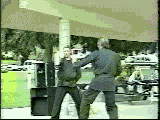 The next stage involves the speed break,
and also hitting multiple dispersed targets. The speed
break is essentially hitting one or two 1" pine boards.
But there's a catch. The boards are now free floating.
There was a time I would throw the board into the air,
and break it on the fly (Sensei Steve Armstrong was
highly skilled at this). That proved to be a bit
hazardous, since it's impossible to control where the
pieces will fly, and yes, bystanders get very upset when
struck by flying debris. I experimented with different
approaches, and finally settled on using a partner,
holding the board with one hand, preferably two fingers.
If demonstrating, I am careful to explain the
significance to the audience, that it's an unsupported
break, like hitting the object floating in air, and
unlike other breaks, requires great focus, speed, and
impact to perform. So far, they always seem to get the
idea, and they certainly do enjoy it. When practicing,
it's pretty much the same, except I do use the synthetic
break boards for the same reason indicated earlier
(saves money!). When you get good at this, it's OK to
try two pine boards (not everybody can do two, it takes
great speed and focus). You're asking for trouble (as in
shattered knuckles) if you try the free break with
multiple synthetic break a boards. I do occasionally
perform the break using three pine boards, at special
events. I have broken my knuckles on four boards.
The next stage involves the speed break,
and also hitting multiple dispersed targets. The speed
break is essentially hitting one or two 1" pine boards.
But there's a catch. The boards are now free floating.
There was a time I would throw the board into the air,
and break it on the fly (Sensei Steve Armstrong was
highly skilled at this). That proved to be a bit
hazardous, since it's impossible to control where the
pieces will fly, and yes, bystanders get very upset when
struck by flying debris. I experimented with different
approaches, and finally settled on using a partner,
holding the board with one hand, preferably two fingers.
If demonstrating, I am careful to explain the
significance to the audience, that it's an unsupported
break, like hitting the object floating in air, and
unlike other breaks, requires great focus, speed, and
impact to perform. So far, they always seem to get the
idea, and they certainly do enjoy it. When practicing,
it's pretty much the same, except I do use the synthetic
break boards for the same reason indicated earlier
(saves money!). When you get good at this, it's OK to
try two pine boards (not everybody can do two, it takes
great speed and focus). You're asking for trouble (as in
shattered knuckles) if you try the free break with
multiple synthetic break a boards. I do occasionally
perform the break using three pine boards, at special
events. I have broken my knuckles on four boards.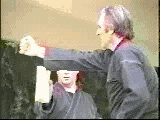
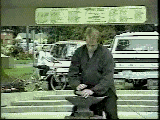 The big leagues of breaking
is large stacks of solid objects (i.e. bricks, tiles,
ice, wood, ... you get the picture), or in the
alternative, an object that is not normally broken with
a strike (rocks, plywood, basketballs, golf balls, ouch,
I can feel the hurt already). It is recorded that at
least one person (the legendary Mas Oyama) tested his
striking skills against a bull (the outcome might have
been different had the bull known what was up).
The big leagues of breaking
is large stacks of solid objects (i.e. bricks, tiles,
ice, wood, ... you get the picture), or in the
alternative, an object that is not normally broken with
a strike (rocks, plywood, basketballs, golf balls, ouch,
I can feel the hurt already). It is recorded that at
least one person (the legendary Mas Oyama) tested his
striking skills against a bull (the outcome might have
been different had the bull known what was up). 